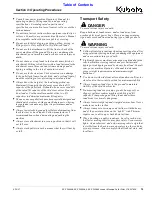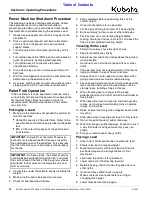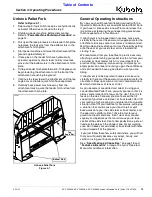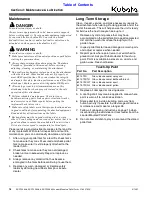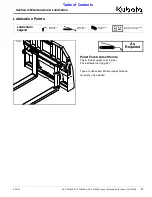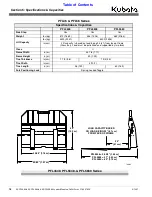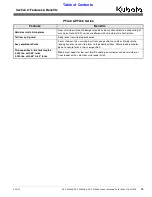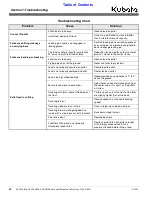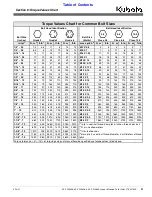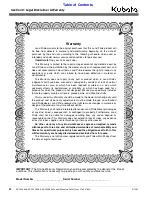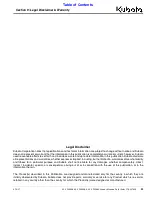
Section 3: Operating Procedures
4/13/21
AP-PFL4648, AP-PFL5648, & AP-PFL5660 Loader Mounted Pallet Forks 319-227MK
14
Power Machine Shutdown Procedure
The following are basic shutdown procedures. Follow
these procedures and any additional shutdown
procedures provided in your skid steer or track loader
Operator’s Manual before leaving the operator’s seat.
1. Reduce engine speed and shut-off all power to the
attachment.
2. Park on solid, level ground and lower attachment
until it is flat on the ground or on non-concrete
support blocks.
3. Turn off engine. Do not remove ignition key at this
time.
4. Turn ignition key to the “RUN” position and relieve all
hydraulic pressure by moving both joysticks.
5. Turn ignition key off and remove to prevent
unauthorized starting.
6. If included, raise seat bar and move controls until
both lock.
7.
Wait for all components to come to a complete stop
before leaving the operator’s seat.
8. Use steps, grab-handles and anti-slip surfaces when
stepping on and off the skid steer or attachment.
Pallet Fork Operation
If the attachment is to be operated in reverse, make
sure visibility to the rear of the power unit is appropriate
for the attachment. Backup camera or mirror is
recommended. Maintain cleanliness of the camera
lens or mirror.
Picking Up a Load
1. Make sure the load does not exceed the smaller of
two lift capacities:
•
Rated lift capacity of the pallet forks. Refer to the
specifications and rated capacity label on the pallet
fork.
•
83% of the rated lift capacity of the skid steer or
track loader.
2. Center forks under the pallet to evenly distribute the
weight.
3. Make sure the load is balanced and secure.
4. Check for overhead obstructions.
IMPORTANT:
Using 83% of the rated lift capacity
accounts for increased loader stresses caused by
the added extension of the pallet fork
.
It also ensures
that the front tires on your skid steer is rated properly
for the job.
IMPORTANT:
On heavy loads, the center of gravity
should
not
be positioned farther than 24" away from
the vertical face of the forks. Picking up heavy loads
positioned farther away can damage the unit and
void its warranty.
5. Stop completely before positioning forks at the
correct height.
6. Drive into the load as far as possible.
7.
Lift load just off the ground and tilt it back slightly.
8. Back out slowly to clear racks or other obstacles.
9. Position load at a safe traveling height before
moving. Two to four inches (5 cm to 10 cm) above the
floor is recommended traveling height.
Traveling With a Load
1. Pedestrians always have the right-of-way.
2. Keep load tilted back slightly.
3. Keep forks low, two to four inches above the ground,
when possible.
4. Continually scan all sides for pedestrians or other
traffic.
5. The operator must have good visibility. If the load is
large and blocks the view, travel in reverse.
6. Always drive at a safe speed and slow down when
going around corners. Avoid sudden braking.
7.
Leave enough clearance when turning to keep pallet
forks and load from contacting obstacles such as
storage racks, buildings, trees, or fences.
8. When traveling over a ramp or incline, keep
palletized load on the “uphill” side of the skid steer or
track loader.
9. When possible, travel straight up and down grades,
ramps, and inclines. Avoid making turns on grades,
ramps, and inclines.
10. Raise or lower load only when stopped, never while
traveling.
11. Slow down when traveling over rough or hilly terrain.
12. Do not transport loads on public roadways.
13. When traveling on public roadways, transport in such
a way that faster moving vehicles may pass you
safely.
14. Plan your route to avoid heavy traffic.
Placing a Load
1. Stop in front of desired location to place the load.
2. Slowly raise load to required height.
3. Move forward slowly with load raised until load is
positioned square and straight above its final
destination.
4. Level load to position it for placement.
5. Lower load onto it final resting location.
6. Before backing, check all sides for pedestrians or
other traffic.
7.
Once load has settled, back up slowly.
8. Make sure forks clear pallet before turning or
changing fork height.
9. Lower forks before moving again.














